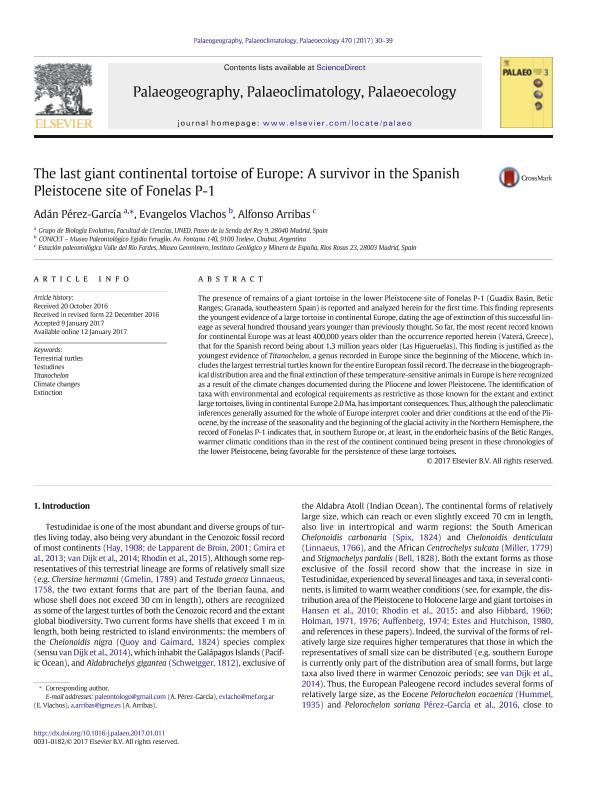Mostrar el registro sencillo del ítem
dc.contributor.author
Perez Garcia, Adan
dc.contributor.author
Vlachos, Evangelos

dc.contributor.author
Arribas, Alfonso
dc.date.available
2018-07-25T18:13:56Z
dc.date.issued
2017-03
dc.identifier.citation
Perez Garcia, Adan; Vlachos, Evangelos; Arribas, Alfonso; The last giant continental tortoise of Europe: A survivor in the Spanish Pleistocene site of Fonelas P-1; Elsevier Science; Palaeogeography, Palaeoclimatology, Palaeoecology; 470; 3-2017; 30-39
dc.identifier.issn
0031-0182
dc.identifier.uri
http://hdl.handle.net/11336/53105
dc.description.abstract
The presence of remains of a giant tortoise in the lower Pleistocene site of Fonelas P-1 (Guadix Basin, Betic Ranges; Granada, southeastern Spain) is reported and analyzed herein for the first time. This finding represents the youngest evidence of a large tortoise in continental Europe, dating the age of extinction of this successful lineage as several hundred thousand years younger than previously thought. So far, the most recent record known for continental Europe was at least 400,000�years older than the occurrence reported herein (Vater�, Greece), that for the Spanish record being about 1.3�million�years older (Las Higueruelas). This finding is justified as the youngest evidence of Titanochelon, a genus recorded in Europe since the beginning of the Miocene, which includes the largest terrestrial turtles known for the entire European fossil record. The decrease in the biogeographical distribution area and the final extinction of these temperature-sensitive animals in Europe is here recognized as a result of the climate changes documented during the Pliocene and lower Pleistocene. The identification of taxa with environmental and ecological requirements as restrictive as those known for the extant and extinct large tortoises, living in continental Europe 2.0�Ma, has important consequences. Thus, although the paleoclimatic inferences generally assumed for the whole of Europe interpret cooler and drier conditions at the end of the Pliocene, by the increase of the seasonality and the beginning of the glacial activity in the Northern Hemisphere, the record of Fonelas P-1 indicates that, in southern Europe or, at least, in the endorheic basins of the Betic Ranges, warmer climatic conditions than in the rest of the continent continued being present in these chronologies of the lower Pleistocene, being favorable for the persistence of these large tortoises.
dc.format
application/pdf
dc.language.iso
eng
dc.publisher
Elsevier Science

dc.rights
info:eu-repo/semantics/openAccess
dc.rights.uri
https://creativecommons.org/licenses/by-nc-sa/2.5/ar/
dc.subject
Climate Changes
dc.subject
Extinction
dc.subject
Terrestrial Turtles
dc.subject
Testudines
dc.subject
Titanochelon
dc.subject.classification
Meteorología y Ciencias Atmosféricas

dc.subject.classification
Ciencias de la Tierra y relacionadas con el Medio Ambiente

dc.subject.classification
CIENCIAS NATURALES Y EXACTAS

dc.title
The last giant continental tortoise of Europe: A survivor in the Spanish Pleistocene site of Fonelas P-1
dc.type
info:eu-repo/semantics/article
dc.type
info:ar-repo/semantics/artículo
dc.type
info:eu-repo/semantics/publishedVersion
dc.date.updated
2018-07-25T13:52:27Z
dc.journal.volume
470
dc.journal.pagination
30-39
dc.journal.pais
Países Bajos

dc.journal.ciudad
Amsterdam
dc.description.fil
Fil: Perez Garcia, Adan. Universidad Nacional de Educación a Distancia; España
dc.description.fil
Fil: Vlachos, Evangelos. Consejo Nacional de Investigaciones Científicas y Técnicas; Argentina. Museo Paleontológico Egidio Feruglio; Argentina
dc.description.fil
Fil: Arribas, Alfonso. Instituto Geológico y Minero de España; España
dc.journal.title
Palaeogeography, Palaeoclimatology, Palaeoecology

dc.relation.alternativeid
info:eu-repo/semantics/altIdentifier/doi/http://dx.doi.org/10.1016/j.palaeo.2017.01.011
dc.relation.alternativeid
info:eu-repo/semantics/altIdentifier/url/https://www.sciencedirect.com/science/article/pii/S0031018216306344
Archivos asociados
